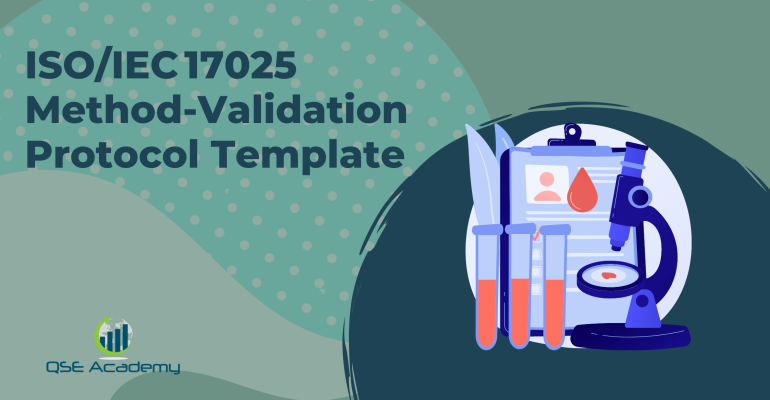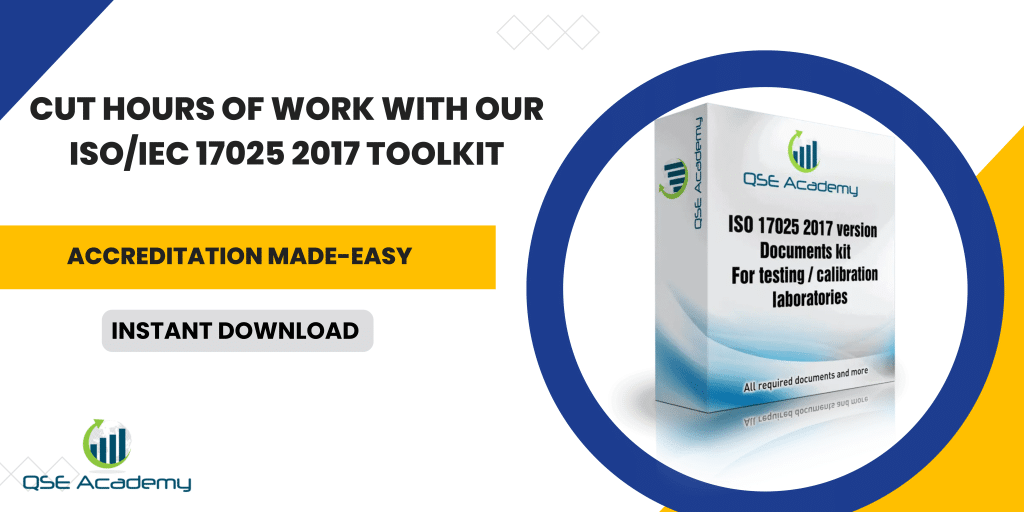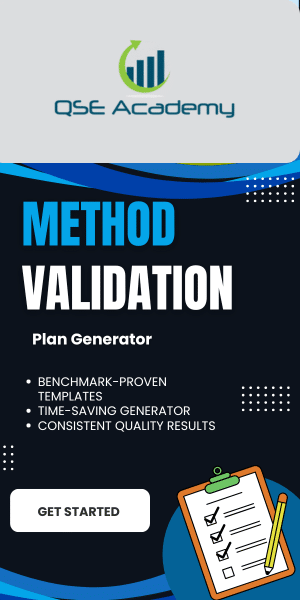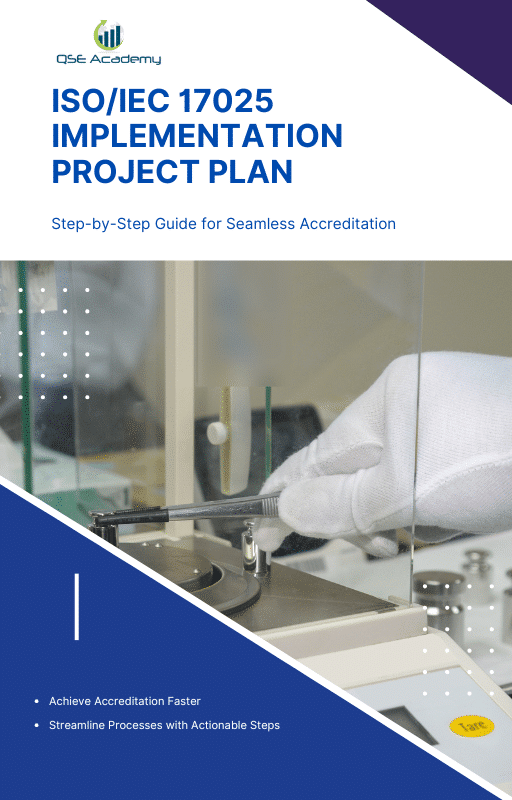ISO/IEC 17025 Method‑Validation Protocol Template
Last Updated on October 13, 2025 by Melissa Lazaro
Why Method Validation Matters for ISO/IEC 17025 Compliance
Ask any lab manager what keeps them up at night before an audit, and “method validation” usually tops the list.
Everyone knows it’s important — but few are confident their documentation actually proves it.
Here’s what I’ve seen over the years:
Labs often do good technical work but fail to show that their methods are truly “fit for purpose.” And under ISO/IEC 17025, that phrase — fit for purpose — is everything. It’s what tells auditors your data can be trusted.
So, what’s the fix? A solid Method-Validation Protocol.
Not a messy collection of spreadsheets and notes — a clear, structured document that walks through every step of your validation process: what you’re testing, how you’re testing it, and how you’ll decide if it works.
That’s exactly what this guide is about. You’ll learn:
-
What ISO/IEC 17025 actually requires when it comes to validation
-
The key elements every protocol should include
-
How to use a simple, repeatable template that saves time and satisfies auditors
-
A few real-world tips to make your data defensible and your paperwork painless
By the end, you’ll know how to design, run, and document method validation with confidence — no guesswork, no wasted effort.
Now, before we jump into the template itself, let’s clear up one question that trips up a lot of labs: What does ISO/IEC 17025 really mean by “method validation”?
Understanding Method Validation Under ISO/IEC 17025
Let’s start with what ISO/IEC 17025 actually expects — because this is where many labs overcomplicate things.
Under Clause 7.2.2 – Selection, Verification, and Validation of Methods, the standard basically asks one question:
Can you prove that your method does what it’s supposed to do, in your lab, with your equipment, and your people?
That’s it. That’s the essence of method validation.
Now, here’s the part that often gets misunderstood: validation isn’t the same as verification.
Verification vs. Validation — What’s the Difference?
-
Verification is confirming that a standard method — say, ASTM, ISO, or EPA — works as intended in your lab. You’re not reinventing the method; you’re proving you can follow it properly.
-
Validation, on the other hand, applies when you develop, modify, or use a non-standard method. You’re proving from the ground up that it’s reliable, accurate, and suitable for its intended purpose.
Example:
If you follow ISO 8655 for pipette calibration, you’re verifying.
But if you’ve designed a new in-house test for chemical purity, you’re validating.
When Validation Is Required
Here are the most common cases when you need a formal validation protocol:
-
You’ve created or significantly modified a test method.
-
You’ve changed matrices (like moving from water testing to soil).
-
You’ve switched equipment, reagents, or key personnel affecting results.
-
You’ve introduced new technology (for example, upgrading from spectrophotometry to HPLC).
Fit for Purpose — The Heart of It All
ISO/IEC 17025 doesn’t expect perfection. It expects fitness for purpose.
Your method doesn’t need to be the most advanced or sensitive — it just needs to produce results that meet your customers’ needs and your claimed uncertainty levels.
Pro Tip:
When you design a validation, start with the question:
“What do I need to prove so that anyone looking at my data would trust it?”
That mindset makes your validation focused, efficient, and auditor-friendly.
Key Components of a Method-Validation Protocol
Once you understand what method validation is, the next step is figuring out how to document it properly.
That’s where your Method-Validation Protocol comes in — it’s your blueprint for how you’ll prove that a method works as intended.
Think of it like a recipe for reproducibility.
It doesn’t just describe what you’ll test — it defines how, why, and what success looks like.
Here’s the structure every solid ISO/IEC 17025 method-validation protocol should include.
1. Objective and Scope
Start by defining what you’re validating and why.
Be specific — include the method name, the parameter you’re measuring, and where it applies.
Example:
“This protocol outlines the validation of an in-house spectrophotometric method for determining nitrate concentration in drinking water, applicable for concentrations between 0.1 and 50 mg/L.”
Pro Tip:
If your lab offers both testing and calibration, make sure you specify which one the validation applies to — auditors notice that.
2. Responsibilities
List who’s involved and what they’re responsible for.
Typical roles include:
-
Analyst / Technician – executes validation experiments and records data
-
Technical Manager – reviews methods, data, and results
-
Quality Manager – ensures documentation and traceability
This shows clear accountability — something auditors always check.
3. Test Principle or Method Summary
Give a short overview of the science behind your method.
Don’t go overboard — this isn’t a journal article.
Just explain how the method measures or detects what it’s supposed to.
4. Validation Parameters
This is the heart of your protocol. List the performance characteristics you’ll evaluate — typically:
-
Accuracy (Trueness)
-
Precision (Repeatability and Reproducibility)
-
Linearity and Range
-
Detection and Quantification Limits
-
Selectivity or Specificity
-
Robustness (stability against small changes)
-
Measurement Uncertainty (when applicable)
Pro Tip:
Put these in a table with defined targets and acceptance limits — it’s clearer and easier to review.
5. Equipment and Materials
Identify the instruments, reference standards, and reagents you’ll use.
Include model numbers, calibration status, and traceability sources.
This section proves your validation is built on controlled, verified resources — a core ISO 17025 expectation.
6. Validation Procedure
Outline the exact steps of the validation testing:
-
Sample preparation
-
Number of replicates
-
Conditions (temperature, environment, etc.)
-
How data will be recorded
Keep it precise enough that someone else could repeat it and get comparable results.
7. Acceptance Criteria
Define what “success” looks like.
Each parameter should have measurable criteria — e.g.,
Accuracy within ±5 %, R² ≥ 0.995, repeatability RSD ≤ 2 %.
Without this, your validation results are just numbers without meaning.
8. Data Recording and Calculations
Describe how raw data will be documented, analyzed, and stored.
If you’re using spreadsheets or LIMS, mention the file paths or form codes.
9. Results and Interpretation
This section is completed after testing — summarize your findings and whether each parameter met the acceptance limits.
Keep it factual; interpretation belongs in your validation report.
10. Approval and Authorization
List who reviews and approves the protocol and final report.
Sign-offs by the Technical Manager and Quality Manager confirm your validation process was controlled and reviewed.
Method-Validation Parameters Explained
Now that we’ve outlined what goes into your protocol, let’s dig into the most important part — the validation parameters themselves.
This is where you prove your method actually performs as claimed.
In other words, it’s the evidence behind your confidence.
I’ve seen a lot of labs trip up here. They collect data — good data — but don’t organize or explain it in a way that convinces an auditor the method is truly “fit for purpose.”
Let’s fix that.
Here’s how to handle each parameter clearly and practically.
1. Accuracy (or Trueness)
What it means:
Accuracy tells you how close your measured values are to the true value.
How to test it:
Analyze a reference material or spiked sample with a known concentration, then compare your results.
Pro Tip:
Always express accuracy as a percentage recovery or bias.
Example:
“Average recovery of nitrate at 10 mg/L = 98.7 % (within acceptance range of 95–105 %).”
That simple line shows control and understanding.
2. Precision (Repeatability and Reproducibility)
What it means:
Precision checks the consistency of your results.
-
Repeatability: same analyst, same equipment, short timeframe.
-
Reproducibility: different analysts, days, or instruments.
How to test it:
Run multiple replicates under both conditions and calculate the Relative Standard Deviation (RSD).
Pro Tip:
A low RSD (typically ≤2–5 %, depending on the test) is your proof that your method is stable.
3. Linearity and Range
What it means:
Shows that your method produces proportional results across the concentration range you claim.
How to test it:
Prepare multiple standards, plot the response vs. concentration, and calculate the correlation coefficient (R²).
Acceptance Example:
R² ≥ 0.995 is a strong indicator of linearity.
Pro Tip:
Include your graph in the report — visuals make validation data easy to interpret.
4. Limit of Detection (LOD) and Limit of Quantification (LOQ)
What it means:
-
LOD: The lowest concentration you can reliably detect (but not necessarily quantify).
-
LOQ: The lowest concentration you can quantify accurately and precisely.
How to determine:
Use the standard deviation of blank measurements or calibration curve slope (e.g., 3σ/S for LOD and 10σ/S for LOQ).
Pro Tip:
Document your calculation formulas and actual test data. Auditors love transparency here.
5. Selectivity (or Specificity)
What it means:
Your method measures only what it’s supposed to — without interference from other components in the sample.
Example:
When testing for nitrates, show that other ions like nitrites or sulfates don’t affect the result.
Pro Tip:
Run interference studies or matrix blanks to demonstrate this. Keep it simple but measurable.
6. Robustness
What it means:
Tests your method’s resilience to small, deliberate changes — like temperature variation or reagent batch differences.
How to test it:
Vary one condition at a time and see if results remain within acceptable limits.
Example:
Changing incubation time from 20 to 25 minutes caused <1.5 % change in result (within limit).
Pro Tip:
Auditors love seeing robustness data. It shows your lab understands real-world variability.
7. Measurement Uncertainty (if applicable)
What it means:
A quantified estimate of the doubt in your result — required especially for calibration labs.
Pro Tip:
Link your uncertainty estimation to your validation data. The two should tell the same story — that your results are consistent, traceable, and reliable.
Step-by-Step Guide: How to Complete the Method-Validation Protocol
Now that you know what goes into a protocol and what each parameter means, it’s time to put it all together — step by step.
This is where you turn the theory into a living document your lab can actually use and defend during an audit.
When I help labs through this process, I always remind them:
“Validation isn’t about proving your method is perfect — it’s about proving it’s predictable.”
Let’s go through the process the way auditors (and smart labs) do.
Step 1: Identify the Need for Validation
Start with the “why.”
Are you introducing a new test? Modifying an existing method? Changing matrices or instruments?
Write that reason clearly in your protocol’s Objective section. It’s what justifies the entire validation.
Example:
“This validation is conducted to assess the performance of a modified spectrophotometric method for phosphate determination after reagent change.”
Step 2: Draft the Protocol
Use your template to plan the validation before running a single test.
This is where you outline parameters, sample sizes, acceptance limits, and data analysis methods.
Pro Tip:
Never start experiments without an approved protocol. Auditors see that as a lack of control — even if your data is perfect.
Step 3: Conduct Validation Testing
Follow your plan exactly as written.
For each parameter:
-
Record conditions (date, operator, instrument ID).
-
Document raw data immediately — handwritten logs or LIMS entries are fine as long as they’re traceable.
-
Note any deviations or anomalies (e.g., a failed calibration check).
Real Example:
A food testing lab I worked with added a short note: “Standard solution B expired mid-test, replaced and retested.”
That simple line prevented a finding because it showed awareness and transparency.
Step 4: Analyze and Compare Results
After testing, calculate your statistics: recoveries, standard deviations, R² values, detection limits — whatever applies to your parameters.
Compare each one against your Acceptance Criteria table.
Pro Tip:
Always explain why results meet or don’t meet criteria. For example:
“RSD = 2.4 %, within target of ≤5 %, indicating good precision.”
That kind of clarity builds confidence with auditors and internal reviewers alike.
Step 5: Document Deviations and Corrective Actions
If something doesn’t meet criteria, don’t panic — document it.
Describe what went wrong, investigate, and retest if needed.
Validation isn’t a pass/fail event; it’s a controlled experiment to find limitations.
Example:
“Original LOD exceeded target. Increased replicate count and reanalyzed — results now within acceptable range.”
That’s maturity, not weakness.
Step 6: Prepare the Validation Report
Once data analysis is done, summarize everything in a Validation Report:
-
Objective
-
Parameters tested
-
Results and statistics
-
Deviations and resolutions
-
Final conclusion (“Method is fit for purpose”)
Attach all supporting data and calibration certificates.
Pro Tip:
Keep your report factual and concise. One page of solid summary data is worth more than ten pages of filler text.
Step 7: Review, Approve, and Archive
Have your Technical Manager and Quality Manager review the full package — the protocol, data, and report.
Both should sign off before implementation.
Finally, archive everything in your controlled document system. Label it clearly so it can be retrieved instantly during audits.
Example Layout: ISO/IEC 17025 Method-Validation Protocol Template
At this stage, you know what to include and how to complete it. Now, let’s look at how your protocol should actually look and flow on paper (or screen).
The key? Keep it clean, logical, and repeatable.
A good template saves hours of writing — and dozens of headaches during audits.
Here’s an example layout you can model your own on.
Method-Validation Protocol Template – Example Format
| Section | Description / What to Include | Reference / Notes |
|---|---|---|
| 1. Objective | State the purpose of validation. Example: “To validate an in-house HPLC method for caffeine determination in beverage samples.” | ISO/IEC 17025 Clause 7.2.2 |
| 2. Scope | Define where and how the method applies (sample types, concentration range, instruments, and lab sites). | Scope of Accreditation |
| 3. Responsibilities | List who is involved: analyst, technical manager, reviewer, quality manager. | Organizational Chart |
| 4. Method Summary | Provide a short description of the analytical or calibration principle. | Method ID or SOP |
| 5. Equipment & Materials | List all major instruments, reference standards, and reagents (with calibration status and traceability). | Equipment Register |
| 6. Validation Parameters | List parameters to be tested: accuracy, precision, linearity, LOD/LOQ, selectivity, robustness, uncertainty (if applicable). | Annex A – Parameter Table |
| 7. Acceptance Criteria | Define numeric targets for each parameter (e.g., RSD ≤ 2 %, recovery 95–105 %, R² ≥ 0.995). | Internal Procedure QP-07 |
| 8. Validation Procedure | Outline the test plan: sample prep, number of replicates, data collection, environmental conditions, etc. | Work Instruction WI-14 |
| 9. Data Analysis | Describe calculations, software, and formulas used to analyze results. | Statistical Method Section |
| 10. Results Summary | Provide space to record outcomes and whether each parameter met criteria. | Validation Data Sheet |
| 11. Deviations & Remarks | Log any issues, corrective actions, or notes for improvement. | Nonconformance Form QF-09 |
| 12. Conclusion | Final evaluation: “Method validated and fit for intended purpose” or “Further testing required.” | Validation Report VR-XX |
| 13. Approval & Authorization | Sign-off lines for Analyst, Technical Manager, and Quality Manager. | Controlled Copy |
Pro Tip: Keep It Modular
Use this same template for every new or modified method — just update the details.
That consistency not only makes your documentation easier to manage but also tells auditors you’re systematic and disciplined.
Example:
A calibration lab I worked with used one standardized template for all new methods. When their assessor asked for a random validation file, every single one looked the same — clean, consistent, and complete. The audit lasted half the time it normally would.
Formatting Tips
-
Use tables for data-heavy sections (parameters, criteria, results).
-
Add page numbers, revision control, and document ID on every page.
-
Keep electronic templates locked (read-only) with editable fields for users.
-
Attach raw data, graphs, and uncertainty calculations as annexes — don’t clutter the main document.
Common Pitfalls and How to Avoid Them
Even the most technically competent labs make mistakes during validation — not because they don’t know the science, but because they overlook the paper trail.
In ISO/IEC 17025, documentation isn’t just proof — it’s protection. It shows your system is under control, repeatable, and defensible.
Let’s look at the most common pitfalls I see during audits — and how you can avoid them.
1. Treating Validation as a One-Time Event
This is the big one.
Many labs validate a method once, file it away, and never look at it again — until a nonconformity shows up.
Validation isn’t a checkbox. It’s a living assurance that your method continues to perform as intended.
How to Avoid It:
-
Re-evaluate methods whenever you change reagents, instruments, or analysts.
-
Review validation data periodically (for example, during management review).
-
Add a short note in your Quality Manual: “Method validation records are reviewed every two years or when significant changes occur.”
That one line turns a static file into a dynamic control.
2. Vague or Missing Acceptance Criteria
A method can’t be “fit for purpose” without clear, measurable targets.
Yet I still see protocols that say, “Results must be acceptable” — which means absolutely nothing to an auditor.
How to Avoid It:
-
Set numerical limits for every parameter.
-
Base them on recognized standards, manufacturer data, or in-house performance history.
-
Document your rationale — a sentence or two explaining why that limit was chosen.
Example:
“Accuracy acceptance limit of ±5 % based on historical method precision and client tolerance levels.”
That’s justification — and justification is what auditors look for.
3. Ignoring Raw Data Traceability
Labs often summarize results beautifully but forget to link back to the raw data — the spreadsheets, logs, or instrument files.
Without traceability, your validation loses credibility.
How to Avoid It:
-
Attach or reference raw data files directly in your protocol or validation report.
-
Include file paths or record numbers (e.g., “Chromatogram 2025-05-14_001”).
-
Keep electronic data backed up and access-controlled.
Pro Tip:
Auditors sometimes ask, “Show me where this number came from.”
If you can open the exact file in seconds, that’s instant confidence.
4. Skipping Statistical Evaluation
Good labs collect numbers; great labs interpret them.
You can’t just state “results are consistent” — you must show it statistically.
How to Avoid It:
-
Calculate RSD, correlation coefficients, and confidence intervals where applicable.
-
Document formulas or cite the statistical method used.
-
Use validation software or a simple Excel sheet with locked formulas to prevent errors.
Auditors appreciate seeing the math behind the conclusion.
5. Missing or Delayed Sign-Offs
This one’s surprisingly common.
Everything’s done perfectly — except no one signed the approval page. That’s an automatic nonconformity.
How to Avoid It:
-
Add signature lines with name, role, and date in every validation protocol and report.
-
Require sign-offs before the method is officially released for use.
It’s simple — but essential.
6. Poor Version Control
If multiple versions of your validation protocol are floating around, you’re asking for trouble.
How to Avoid It:
-
Assign document IDs and revision numbers.
-
Keep only the current version accessible to staff.
-
Archive older versions in a separate, clearly marked “superseded” folder.
7. Over-Documenting (Yes, That’s a Thing)
Some labs drown in data, thinking more pages equal better compliance.
In reality, it just hides the important stuff.
How to Avoid It:
Focus on clarity — not volume. Summarize, reference, and attach only what’s relevant.
Remember: auditors look for control and comprehension, not bulk.
FAQs: Clarifying Method Validation for ISO/IEC 17025
Even after you’ve built a solid protocol, questions always pop up — especially during audits or when new staff start learning the ropes.
Here are the most common questions I get from labs about method validation under ISO/IEC 17025 — and the straight answers that clear the confusion fast.
1. What’s the difference between method validation and method verification?
This one causes more anxiety than it should.
Here’s the simple way to remember it:
-
Verification = proving a standard method works in your lab.
You’re confirming that a recognized method (like ASTM, ISO, or EPA) performs correctly under your conditions — same reagents, instruments, and environment. -
Validation = proving a new or modified method works reliably.
This applies when you’ve developed your own method, changed a standard one, or use it outside its original scope (different matrix, instrument, or range).
Example:
If you’re following ISO 11133 for microbiological water testing — that’s verification.
If you adjust incubation time or temperature to suit your samples — that’s validation.
Pro Tip:
If you change anything that could affect performance, treat it as validation. It’s safer — and auditors respect the thoroughness.
2. Who should approve a validation protocol and report?
Auditors always check this.
Typically, three people are involved:
-
Analyst or Method Developer: Prepares and executes the validation.
-
Technical Manager: Reviews the data and determines technical adequacy.
-
Quality Manager: Verifies documentation control and compliance with ISO/IEC 17025 requirements.
All three signatures matter. Missing one looks like a system gap.
Pro Tip:
If your lab is small and one person wears multiple hats, note that clearly in the Quality Manual — auditors just need transparency.
3. How often should a method be revalidated?
ISO/IEC 17025 doesn’t give a fixed timeline — it depends on changes and risk.
Revalidation is required when:
-
There’s a change in equipment, reagents, or personnel affecting performance
-
The environment or sample type changes significantly
-
You expand or narrow the measurement range
-
You have recurring quality control issues
Otherwise, ongoing monitoring (like control charts and proficiency testing) keeps your validation current.
Pro Tip:
Add a clause to your procedure:
“Methods are revalidated when significant changes occur or every five years, whichever comes first.”
That statement alone satisfies most auditors.
4. Can I reuse the same validation protocol template for multiple methods?
Absolutely — that’s the smart way to do it.
Just customize the details (method name, parameters, ranges, acceptance criteria).
Consistency across validations shows system control — and makes reviews faster.
5. What kind of evidence do auditors expect to see?
Auditors want to see the full picture — not just results.
That means:
-
The protocol (plan)
-
The raw data (proof)
-
The report (summary and conclusion)
-
The approval signatures (accountability)
If you have all four — you’re covered.
Pro Tip:
Keep them stored together under one file or folder name (e.g., “Method Validation – HPLC-Caffeine – 2025”).
That organization alone saves 20 minutes of fumbling during audits.
Making Method Validation Simple and Defensible
By now, you’ve seen that method validation under ISO/IEC 17025 isn’t about creating endless paperwork or checking boxes for the auditor.
It’s about confidence — in your results, your process, and your people.
In every accredited lab I’ve worked with, the ones that truly excel all share one trait: they treat validation not as a burden but as proof of their technical integrity. Their data tells a story — one of consistency, accuracy, and control.
Let’s be honest — validation can feel intimidating at first. But when you have a clear, structured protocol and a reusable template, it becomes a routine part of good science.
Here’s what to remember:
-
Start with purpose. Know why you’re validating — not just what you’re testing.
-
Follow the plan. Your protocol is your map — don’t improvise mid-way.
-
Quantify performance. Numbers, graphs, and evidence build trust faster than paragraphs.
-
Document as you go. The best validation records are the ones written while the work happens.
-
Review and learn. Every validation strengthens your lab’s competence — and your next one will always be smoother.
Real-world truth:
I’ve watched small labs with limited resources outperform large facilities in audits, simply because their documentation was clear, organized, and defensible. That’s the power of a well-designed validation protocol.
Your Next Step
If you’re setting up or refining your system, don’t start from scratch.
QSE Academy offers a ready-to-use ISO/IEC 17025 Method-Validation Protocol Template — complete with parameter tables, acceptance criteria, and built-in traceability sections.
Or, if you want something tailor-fit to your specific testing or calibration scope, our consultants can help you design a custom validation protocol that aligns perfectly with your methods and accreditation goals.
Because in the end, the goal isn’t just passing an audit — it’s building confidence in every result your lab produces.
That’s what true ISO/IEC 17025 competence looks like.
I hold a Master’s degree in Quality Management, and I’ve built my career specializing in the ISO/IEC 17000 series standards, including ISO/IEC 17025, ISO 15189, ISO/IEC 17020, and ISO/IEC 17065. My background includes hands-on experience in accreditation preparation, documentation development, and internal auditing for laboratories and certification bodies. I’ve worked closely with teams in testing, calibration, inspection, and medical laboratories, helping them achieve and maintain compliance with international accreditation requirements. I’ve also received professional training in internal audits for ISO/IEC 17025 and ISO 15189, with practical involvement in managing nonconformities, improving quality systems, and aligning operations with standard requirements. At QSE Academy, I contribute technical content that turns complex accreditation standards into practical, step-by-step guidance for labs and assessors around the world. I’m passionate about supporting quality-driven organizations and making the path to accreditation clear, structured, and achievable.












